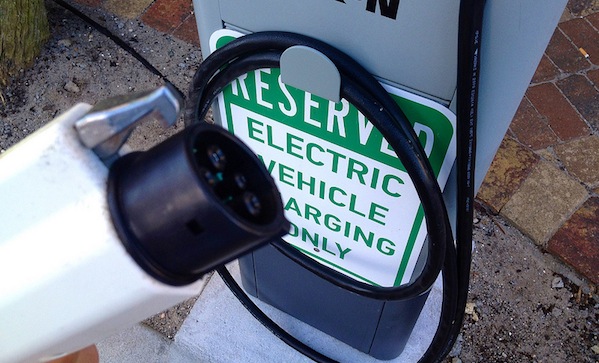Socket to me! Is it fair to compare the world’s first two mass-market electric vehicles? Of course not, and it’s less fair when one of the two is pure electic and the other has a gas-engine backup. Is life fair? Of course not, and it’s less fair when one person can get the upper hand on another simply by visiting the right web site at the right time. (Oh, internet, how do you sleep at night?)
These fist-shaking injustices acknowledged, let’s compare the 2012 Nissan LEAF to the 2012 Chevrolet Volt.
First, I’ll state that when I am not making direct distinctions in this article, I intend to mention the LEAF first, simply because it hit the Canadian automotive market first. Second (and speaking of right web site(s)/right time), this article is not a review of either electric vehicle. I will happily steer you to the following two Canadian reviews, whose summarized experiences closely enough reflect my own: this LEAF review, and this Volt review.
To cut to the charge: here are the two most important determinants for owning an electric vehicle in Canada. One: Are you urban? (Sub-question: If you are a condo dweller, is there anywhere to plug in?) Two: Will the electric vehicle be your only vehicle?
The urban question: With some small reservations, both the LEAF and Volt are terrific urban vehicles. Compact — so, easy to park. Range, decent on an overnight charge — so great for the urban A-to-B-to-C multi-destination, short-distance driver; more on this in a moment. Nimble, and then some: both handle superbly (if you’re the kind of driver who derives smug satisfaction from passing on the right, you’ll be very happy). I’ll give the Volt a small bonus mark for its elephant (by weight) of a propulsion system — two engines, one electric, one gas — whose heft has no discernible impact on the zippy, zippy performance but keeps the car nice and grounded, with major oomph, when swerving. Then again, I must subtract a point for Volt’s bizarre under-carriage extended fender(?), which hangs so low that you’ll scrape it on — speed bumps, absolutely, but also… — on driveway curbs over 3 inches tall!
Given performance similarity, you’ll opt LEAF or Volt based on various criteria. Let’s assume price, exterior design and range are your biggest drivers.
Base price for the LEAF (SV model) is $38,395; I tested an SL, $39,995; base price for the Volt is $41,545; I tested a premium-trim model, $44,135. Note that different provinces (and both manufacturers) offer rebates/purchase incentives, yeilding a maximum saving of almost $10K. Still, call the cars $ame-$ame, as you are roughly in the $40K range.
Exterior design is a big variant, and your choice will say a lot about your self-aware image. Despite being a very traditional-looking hatchback, LEAF has been well-branded (so far) by Nissan as the “look” of the electric car. Volt, by comparison, is sleeker; but even if it borders on sporty, it’s still no head-turner. Basically, you’ll choose LEAF if you want people to know you’ve gone electric, and Volt if you only want in-the-know people to know.
Without going all city/highway, here, LEAF gives you roughly twice the range of the Volt. To radically generalize: assume you will get 120 km off of a fully charged LEAF, requiring 18hrs to fully recharge*, and 60 km off of a fully charged Volt, requiring 10hrs to fully recharge. (*Both vehicles accomodate partial recharge — plug in whenever/wherever you can, because every little bit helps, and non-drained charge levels do not affect battery memory/capacity.) Both vehicles also feature regenerative braking — but don’t count on this negligible amount of “extra” charge-as-you-go to get you, well, anywhere.
Whether your living situation involves one vehicle or two — now, this is the more interesting criterion of choice. Sure, get either the LEAF or the Volt as a second car. And use it as much as possible. At this point, I would go LEAF; notable criteria: cabin comfort (more headroom), dashboard/tech interface (love the concentric circle navi + range indicator), seating (5, compared to Volt’s 4).
But the more solid driving you have to do, and particularly if you are a one-car urbanite, lean slightly further Volt. It yeilds the promised 60km electric — approx. one third less than that, pure highway — then kicks in some 450km of gas backup. LEAF performs similarly, yeilding approx. 90km pure highway — and of course with no gas backup, you get the “white knuckle” threat. I feel almost bad for adding that sensationalizing link, but you must bear in mind that, regardless of whether you have a LEAF or a Volt, you will not always remember to charge the car, and even if you do, you will push its limits. I drove each for one week, and white knuckled the LEAF once — my fault entirely, but still stressful — and ended up on gas on the Volt twice.
It will be fascinating to watch these cars evolve over the next, say, 2 years. (Or: Moore’s Law, as applied to automotive tech.) Once the LEAF’s range doubles or triples, it will be downright dangerous. Still, for the here and now, I couldn’t be happier to report that choosing between the 2012 Nissan LEAF and the 2012 Chevrolet Volt is difficult, in the very best sense of the word. Both electrics are “guilty,” as charged, and both deliver a fun, guilt-free driving experience.
——————–
Image courtesy of TheDigitel Myrtle Beach.



good job leaving out cold weather range